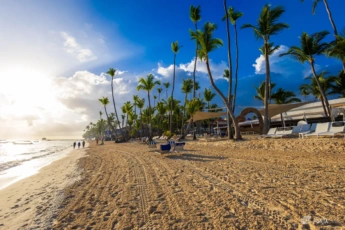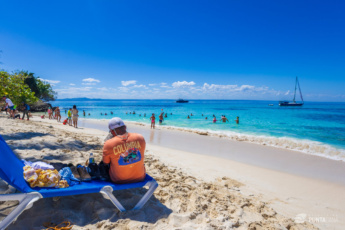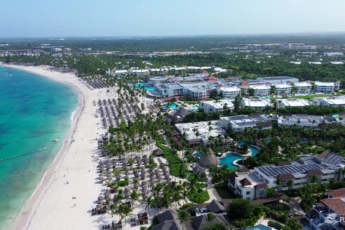Hurricane season in the Dominican Republic 2025
Surrounded by the Caribbean Sea and the Atlantic Ocean, Hispaniola (Haiti on our maps) is the perfect beach destination. The Dominican Republic, which occupies two-thirds of its area, is one of the most popular tourist destinations. You can relax here at any time of the year, and even during the hurricane season.
What is the current situation in the Dominican Republic after hurricane Fiona swept through the country
In brief, on September 18-19, 2022, Hurricane Fiona passed through the Dominican Republic. And since September 20, it no longer poses any threat to residents and tourists in the Dominican Republic. You have an opportunity to watch the actual situation in the Dominican Republic movement live (based on information from windy.com)
If you are wondering how to plan a vacation and where better to go, we recommend you check the weather in advance and you can do the following:
- Get all the weather information on the internet by yourself – on websites like windy.com. This website provides such features as: simultaneously predict the weather, watch hurricanes live, monitor the level of atmospheric pressure, and check wind speed and direction. This is an excellent tool for analyzing the weather before you go on vacation. You can pinpoint any location on the map and get a weather forecast for the parameters that you have set. This website provides the ability to track a large amount of weather information in real-time.
- Another option is to contact us directly and get all the information about current situation in Punta Cana and all possible factors that can directly or indirectly affect the safety and comfort of your vacation in the DR. Feel free to ask our assistants about the current weather situation in Punta Cana or about any other information that you need before your trip to the Dominican Republic.
Did Punta Cana get hit by Hurricane Fiona?
On September 19, 2022, Hurricane Fiona transformed from a tropical storm to a category one hurricane. According to the Saffir-Simpson Scale, hurricanes are classified as categories 1 to 5, based on a hurricane’s maximum sustained wind speed, where 5 consists of storms with winds of 157 mph (252 km/hr) or higher.
On the territory of the Dominican Republic, the wind reached 89 mph (144 km/h). On Wednesday, September 21 Fiona strengthened to a Category 4 storm with sustained winds of 130 mph (209 km/h) and reached the Bermudas. On Saturday, September 24, Fiona hit the east coast of Canada, bringing winds of 90 mph (145 km/h) and heavy rains, based on the data provided by the windy.com interactive map.
Two days of strong winds and heavy rain are in the past, and now hotel workers are repairing the storm’s damage to the beach umbrellas and removing fallen trees and shrubs. The hurricane also brought a lot of seaweed to the beaches, so it requires a few days to clean everything up. The hurricane affected the infrastructure nearby the sea, such as restaurants, hotel rooms facing the sea, kiosks, and umbrellas on the beaches and docks.
If you plan to visit the Dominican Republic during periods of hurricanes it can be wiser to choose private apartments or a villa. All the territories a bit far from the coastline are safer because there are not so many objects of infrastructure that can be damaged.
Besides, if you decide to use our accommodation services, you can always ask us to send you actual pictures or videos of the apartments and nearby areas. There is one more benefit of visiting Punta Cana during low season – you can save money. Usually, all services are 30% cheaper than during the busy months of the high season.
How Hurricane Fiona affected the entire Dominican Republic?
- The most damage was caused to the eastern regions, where The Dominican Republic government declared a state of emergency in eight provinces. About 2,000 shelters were prepared in the DR on the eve of the storm.
- Warnings about impending weather were sent to all residents and guests of the country. People were informed that it is important to remove things and furniture from the terraces and balconies, as well as check whether the gutters are not full.
- Unfortunately, two human lives were lost. One 72 year-old man was killed by a fallen tree and an 18 year-old lady was struck by an electric pole that fell because of strong winds. About 400 houses were damaged. The Punta Cana International Airport stopped its operations for one day. On 19 September it resumed its work.
How to protect yourself from hurricanes?
The best way to protect yourself – it is to check the weather in advance. But if bad weather catches you off guard, follow the standard recommendations to protect yourself during the hurricanes such as:
- Stay at home far from windows
- Use a portable battery charger, to be able to check the news
- Turn off the main water, gas, and power sources at home
- If you are not in the house or a shelter, you should stay away from floodwater and power lines
How often do hurricanes happen in the Dominican Republic?
Here, you can see a list of all hurricanes that happened in the Dominican Republic.
| Name | Category | Date | Location |
|---|---|---|---|
| Oscar | 1 | Oct 9-22, 2024 | El Valle, Yuma, Cibao |
| Ernesto | 1 | Aug 9-20, 2024 | El Valle, Yuma, Cibao |
| Beryl | 4 | Jul 2, 2024 | Juancho on the southwestern coast |
| Franklin | 1 | Aug 23, 2023 | Pedernales Province on the southwestern coast |
| Fiona | 1 | Sep 19, 2022 | E. Coast, Cap Cana, Punta Cana, Higuey, to Samana (N. Coast) |
| Maria | 3-1 | Sep 19, 2017 | E. Coast, Punta Cana, to the N. Coast, to Santiago & San Francisco |
| Jeanne | 1-3 | Sep 16, 2004 | East Coast, Samana, and Puerto Plata |
| George | 4-3 | Sep 22, 1998 | Santo Domingo and La Romana |
| Hortense | 3-1 | Sep 10, 1996 | East Coast, Punta Cana to Samana |
| Gilbert | 3 | Sep 11, 1988 | Barahona on the southwestern coast |
| Emely | 4-2 | Sep 22, 1987 | Bani on the southwestern coast |
| David | 5-4 | Aug 31, 1979 | Santo Domingo |
| Eloise | 1 | Sep 13, 1975 | Landfall on the northeast coast |
| Beulah | 4 | Sep 10-11, 1967 | Barahona on the southwestern coast |
| Inez | 4-3 | Sep 29, 1966 | Barahona on the southwestern coast |
| Edith | 2 | Sep 26-27, 1963 | La Romana on the southeastern coast |
| Katie | 1 | Oct 16, 1955 | Barahona on the southwestern coast |
| San Zenon | 4 | Sep 3, 1930 | Santo Domingo |
| Lili | 3 | Sep 21, 1894 | Santo Domingo and the southwestern coast |
When is hurricane season in the Dominican Republic?
Hurricanes are common in the Caribbean. The hurricane season in the Dominican Republic is from June to October. The strongest in recent years were Irma and Maria, which in 2017 fell on the country within one month. But if these hurricanes almost completely destroyed the neighboring islands and states, then in the DR there were no significant disasters. Here the element passed only by torrential showers and strong gusts of wind. It’s all about an extremely favorable geographical position – usually the cyclon comes from the west, so it is believed that the western part of the island, on which the state of Haiti is located, is more at risk.
As a lot of people think, that it is really worth fearing the hurricane season in the DR, or monsoon. Gusty winds begin to rage on the islands in August, and often become a real natural disaster. Thus, traveling can be not only uncomfortable, but also life-threatening. Usually, if suddenly there is some desperate traveler who wants to get to the Dominican Republic during hurricanes, any travel agency will dissuade him or her and warn about the possible consequences.
Yes, in August, September and October, sometimes it is better to skip the trip to the Dominican Republic, as it rains much more. In addition, hurricane winds come to the islands. The period from August to November is considered a real off-season here, and often brings a lot of troubles and troubles to the locals.
The peak of hurricanes occurs in August and September. In October, there are fewer of them, but this month is still considered unfavorable for visiting the resort. No one can guarantee that a strong storm or typhoon will not break out in October. In addition, the monsoon season adversely affects health due to high air humidity. During this period, the tropical heat becomes a real test for the body.
Hurricanes, cyclones and tropical storms in the DR
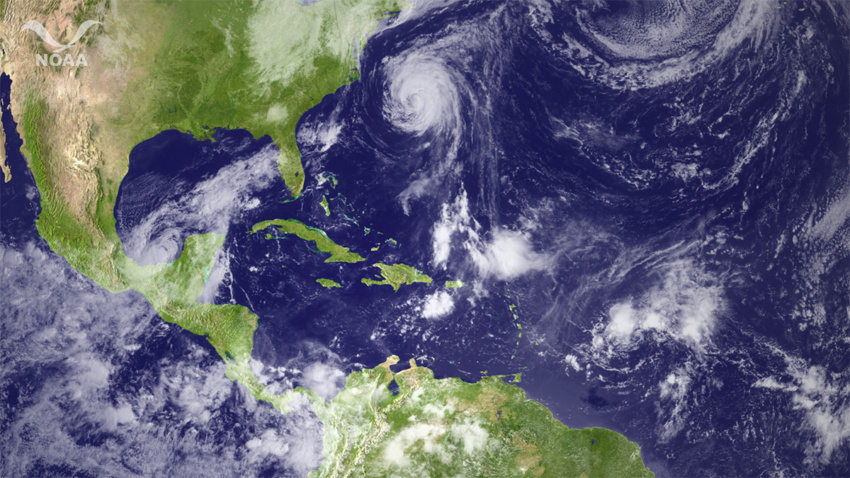
Caribbean hurricane season
The meteorological centers of the Caribbean and the United States track tropical cyclones from the very moment they form, which is approximately 7-10 days before they reach the Caribbean. In this case, several scenarios are possible:
- A tropical cyclone will disappear before it reaches the Caribbean – this is the most common variant. During the Atlantic hurricane season, about 10 to 15 cyclones are formed, and this is how they walk across the Atlantic and do not bring any inconvenience. Some of them even develop into tropical depressions and tropical storms, but things do not go any further and poses no danger to the Caribbean.
- A tropical cyclone turns into a hurricane and sweeps across the Caribbean. On average, approximately two tropical cyclones per season develop into the hurricane category. Hurricanes are also different, in strength from 1 to 5 points, which measure their danger to people. Hurricanes of the highest category do not happen every season.
Which Caribbean islands get hit the most with hurricanes?
Most of the hurricanes go to the small East Caribbean islands, which are located just on their way. In 2016, small Dominica suffered a lot (not to be confused with the Dominican Republic!), The Virgin Islands suffered in the years before last, and in 2017 hurricane Irma razed the islands of St. Martin and Barbuda to the ground, more precisely flooded with water.
The problem with these islands is that there is nowhere to run away. Houses made of cardboard, a very small area – hence the great destruction and even casualties. With some kind of storm, if not a hurricane, then some of these islands are likely to be destroyed every couple of years. But serious destruction does not happen there every year. For example, destruction comparable to that of Hurricane Irma last happened in this region almost 90 years ago!
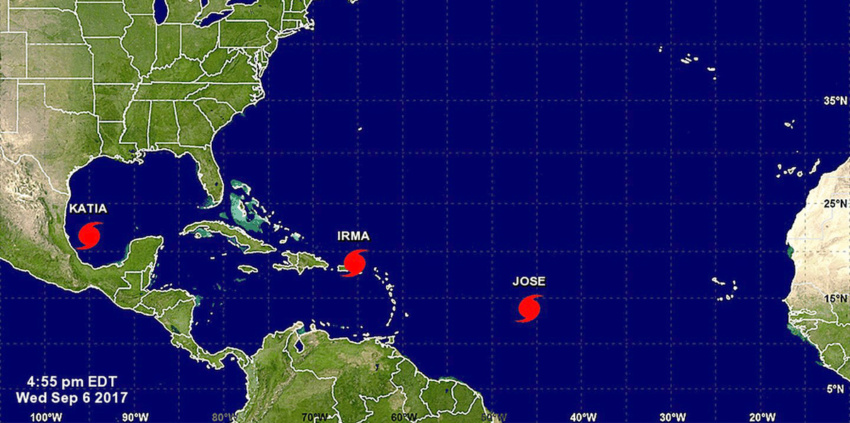
Atlantic tropical cyclones and disturbances
As you can see on the map, these hurricanes hit Puerto Rico, the Dominican Republic, Cuba, nearby islands such as the Bahamas and hit the United States. The United States is the second most dangerous region for hurricanes after the small Caribbean islands. Regardless of their trajectory, most hurricanes end there. However, the undoubted advantages of the States – there is where to go! You can get in a car or public transport and you are already out of the zone of action of the elements, everything is very easy.
Puerto Rico is next in danger. Hurricanes, although they are already turning to the United States, can hit quite well. But the Dominican Republic and Cuba get it relatively rarely. Real hurricanes on these coasts meet on average once every 5-10 years, and destructive hurricanes are even less frequent.
Is Punta Cana a safe place during the hurricane season?
You should definitely know that the safest place in the Dominican Republic is the city of Punta Cana, protected from the ocean by a mountain ridge. So the spray of hurricane waves doesn’t reach Punta Cana, and the tourists enjoy a serene vacation. In any case, almost all hotels have secure hiding places (conference rooms and fitness centers are usually used for this purpose), and staff have clear instructions on how to act in an emergency.
During major hurricanes, usually the hovels of the poor locals are destroyed since they are very flimsy. Having visited the Dominican Republic at least once, look at ordinary villages and you will understand why there is so much destruction during hurricanes.
It is worth noting that during the rainy season in the Dominican Republic you can have a great time, especially since prices are reduced compared to the high tourist season, so a trip to this amazing place, located in a tropical climate, starting from May to November, becomes more affordable. The rainy season in the Dominican Republic is a great opportunity to spend a vacation for those who are engaged in extreme sports. The fact is that the Yaka del Norte river becomes full-flowing, and its rugged rapids are perfect for rafting and kayaking!
Is it worth going to the Caribbean during hurricane season?
Yes! Despite the fact that the hurricane season happens every six months, in most cases these are just pictures of tropical cyclones crossing the Atlantic without prejudice to your vacation. The chances of being in the Caribbean exactly at the time of a hurricane of the highest category are extremely low. Anyway, there will be plenty of time to calmly leave for a safe part of the country or leave the country altogether.
The danger of these hurricanes is mainly for local people who refuse to leave their property and move to safe areas even if a mandatory evacuation is announced. Tourists don’t have such problems. Well, for the paranoid, to be sure, you can exclude from visiting the East Caribbean Islands and the United States in September-October, that are usually the peak of hurricane activity.
Frequently Asked Questions
What is the rainy season in the Dominican Republic?
Rainy season in the Dominican Republic begins in early April. But precipitation in April and May is quite low. During these months tropical showers last no more than 30 minutes, and after them the hot sun reappears. At the same time, the air temperature is about 30 degrees, and the sea temperature is about +28C. In short, this time is quite suitable for a beach holiday, and many travelers are in no hurry to close the season. In addition, the period from April to August is the cheapest. Prices for hotels and excursions are markedly reduced compared to the tourist season.
In the Dominican Republic, any season is suitable for a beach holiday. Temperature fluctuations throughout the year are quite insignificant: from 27 to 33 degrees. The climate is mild and pleasant. The rains here are short – no more than 5-10 minutes, and after there are the bright sun shines again. The rainy season here is from May to October. But this definition is rather arbitrary. Because heavy rains are extremely rare. Usually it rains at night and does not interfere with spending the whole day on the beach. And the water in the ocean stays warm (25-30 C) all year round and is perfect for swimming.
The rainy season in the Dominican Republic does not usually deter tourists. Of course, from April to July, the beaches don’t get as crowded as during the high season. However, travelers from all over the world continue to come here to enjoy a beach holiday on the shores of the Caribbean Sea.
When was the last hurricane in the Dominican Republic?
The strongest hurricanes in recent years were Irma and Maria, which in 2017 fell on the country within one month. But if these hurricanes almost completely destroyed the neighboring islands and states, then in the Dominican Republic there were no significant disasters.
Updated on: . Author:

